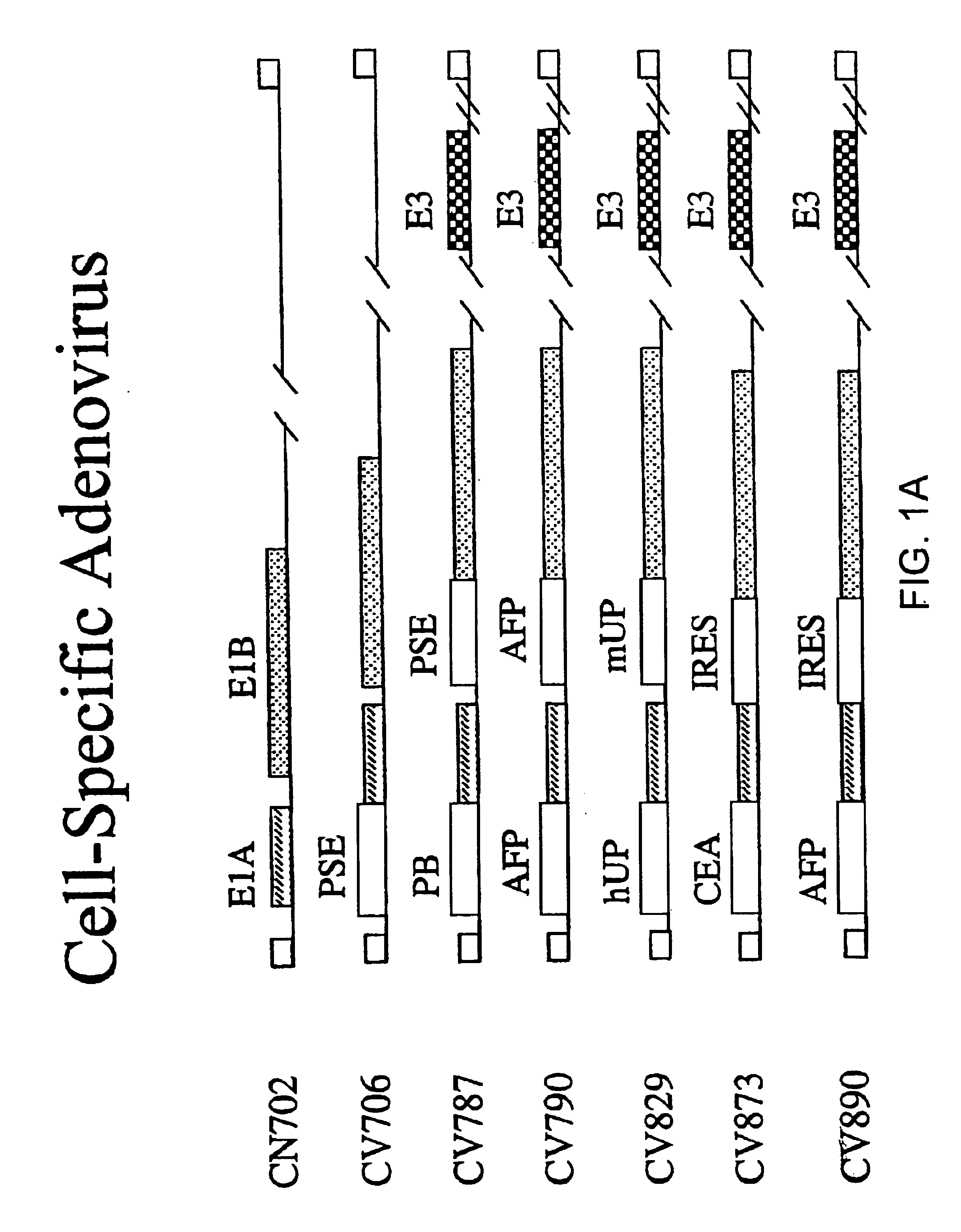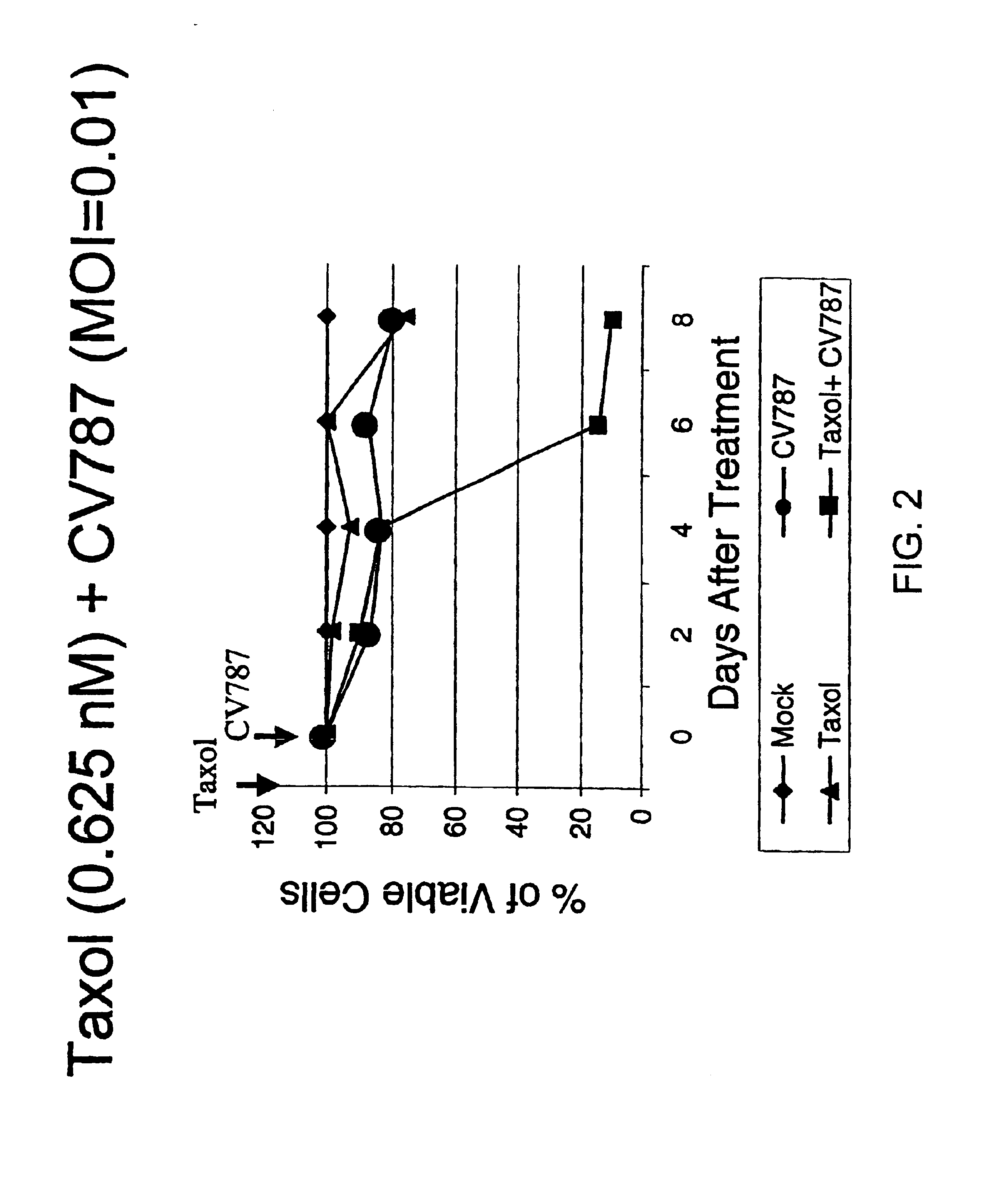Methods of treating neoplasia with combination of target-cell specific adenovirus, chemotherapy and radiation
a technology of adenovirus and adenocarcinoma, which is applied in the field of cell transfection, can solve the problems of incompetent dna replication, inability to replicate dna, and significant disadvantages and limitations of each treatment regim
- Summary
- Abstract
- Description
- Claims
- Application Information
AI Technical Summary
Benefits of technology
Problems solved by technology
Method used
Image
Examples
example 1
Treatment of in vitro Tumor Cells With Combined Prostate Cell Specific Adenoviral Vector CV787 and Chemotherapy and in vivo Assessment.
[0373]In vitro Assessment.
[0374]CV787 is a prostate-specific, replication competent adenovirus vector that preferentially replicates in prostate cancer cells. In this vector, E1A is under transcriptional control of a 452 bp PB TRE, and E1B is under transcriptional control of 1.6 kb PSA-TRE. CV787 alone can, in a single intratumoral dose (1×108 particles per mm3 of tumor) or a single intravenous dose (1×1011 particles per animal) eliminate established tumors within 6 weeks in nude mouse xenografts. The data below demonstrate that CV787-mediated, replication-dependent oncolytic cytotoxicity can be enhanced in conjunction with standard chemotherapeutic agents including paclitaxel (TAXOL™), doxorubicin, mitoxantrone and docetaxel (TAXOTERE™), while the specificity of CV787-based cytopathogenicity remains specific to prostate cancer cells. These data sugg...
example 2
In vitro Treatment of HepG2 and Hep3B Tumor Cells With Replication Competent Target Cell-specific Adenoviral Vector CV790 and Chemotherapy
Regimen for in vitro Study of Adenoviral Vector and Chemotherapeutic Agent
[0415]A preliminary experiment was performed to compare three different protocols: Adding virus first, drug first or virus and drug together (FIGS. 15-17). HepG2 and Hep3B cells were treated with 10 ng / ml doxorubicin and 0.01 MOI of CV790. FIG. 15 shows a synergistic effect in the panel of virus infection first. Virus first indicates administration of the virus about 10-14 hrs before drug application. Drug first indicates administration of the chemotherapeutic agent 10-14 hrs before virus infection FIG. 16. The results of administration of adenovirus vector and drug together are shown in FIG. 17. For the combination of CV790 and doxorubicin, virus first administration resulted in the greatest killing of liver cancer cells. This order of administration was not the most effect...
example 3
In vitro Treatment of HepG2 and Hep3B Tumor Cells With Replication-competent AFP-producing Cell-specific Adenoviral Vector CV790 and Combination Chemotherapy
[0429]In addition to screening single chemotherapeutic agents co-administered with replication-competent target cell-specific adenoviral vectors, a screen was completed of a number of combination chemotherapy regimens which were co-administered with CV790, a hepatoma specific adenoviral vector. Examples of such combination or multiple drug chemotherapy regimens can be found in Table 2. The protocols for the administration of the drugs and virus were as described in Examples 1 and 2, as was the monitoring of cell viability by MTT assay. The regimen followed was the virus first regimen. A range of drug concentrations were tested.
[0430]Treatment of hepatoma cells (Hep3B and HepG2) with a combination of multiple chemotherapy drugs plus CV790 showed a synergistic enhancement of cytotoxicity toward the hepatoma cells compared to the t...
PUM
 Login to View More
Login to View More Abstract
Description
Claims
Application Information
 Login to View More
Login to View More - R&D
- Intellectual Property
- Life Sciences
- Materials
- Tech Scout
- Unparalleled Data Quality
- Higher Quality Content
- 60% Fewer Hallucinations
Browse by: Latest US Patents, China's latest patents, Technical Efficacy Thesaurus, Application Domain, Technology Topic, Popular Technical Reports.
© 2025 PatSnap. All rights reserved.Legal|Privacy policy|Modern Slavery Act Transparency Statement|Sitemap|About US| Contact US: help@patsnap.com



